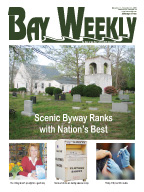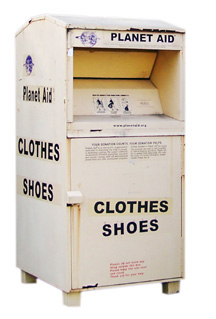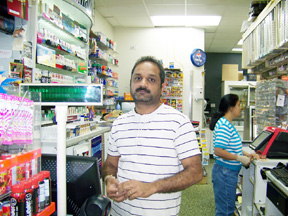
Chesapeake Bay's Independent Newspaper ~ Since 1993
1629 Forest Drive, Annapolis, MD 21403 ~ 410-626-9888
Volume XVII, Issue 45 ~ November 5 - November 11, 2009
Home \\ Correspondence \\ from the Editor \\ Submit a Letter \\ Classifieds \\ Contact Us
Dining Guide \\ Home & Garden Guide \\ Archives \\ Distribution Locations \\ Advertising
![]()

The Yellow Box Front
Your used clothes are making somebody money; it’s up to you to decide who
by Simone Gorrindo
On a fall afternoon, traffic whizzes by HB Fuller Wine & Spirits on Bestgate Road, the wind kicking up fallen leaves. A minivan pulls into the parking lot, stopping next to a bright yellow bin marked Planet Aid: Clothes, Shoes. A young man jumps out with a big plastic bag hoisted over his shoulder.
“I live just up the street,” Annapolitan Bill Whitcher says as he tosses the bag of old clothes into the bin’s slot, topping off other bags of sweaters and shirts that have filled the box to its brim. “I chose Planet Aid because it’s convenient, but I don’t know anything about them.”
Whitcher is not the only one taking advantage of the bin’s convenience. Every day, people drop clothing into lately familiar Planet Aid drop-off boxes that get so full “sometimes they overflow onto the ground,” says Betty Fuller, co-owner of the liquor store that hosts this box on Bestgate Road.
The non-profit collects around 250,000 pounds of used clothing and shoes a week from the area stretching from Frederick to Richmond and including Anne Arundel County, Baltimore and Washington, D.C. That amounts to 13 million pounds a year — a staggering total of our old boots, winter coats, outgrown jeans and last season’s heels.
Like Goodwill and Salvation Army, Planet Aid sells your old clothes for profit, using the proceeds for its programs. The strategically placed boxes brought the otherwise little-known organization $20 million in 2006, the most recent figure reported by the Better Business Bureau. The wealth the organization has reaped from our disposable habits puts new life into the saying One man’s trash is another’s treasure.
Convenience is the key to Planet Aid’s success. Throughout our region (except in Calvert County, which is another chapter of our story) Planet Aid boxes abound: in the back of gas stations, at the far ends of run-down shopping centers, in front of small businesses on busy thoroughfares. By making it easy for us to unburden ourselves of our old junk, Planet Aid is making a fortune.
The smart, efficient non-profit has achieved its wealth in little more than a decade. In 1997, Planet Aid started small in Boston with 57 bins. Now the yellow boxes have spread throughout the country, moving into 12 metro areas with 11,000 bins. In August, Planet Aid placed its 1,000th bin in the Baltimore-Washington region, in front of Don’s Flowers in Fallston, Maryland. Planet Aid is now “collecting donations in pretty much the whole metro area,” says Cameron Aylesworth, operations manager of Planet Aid’s Baltimore-Washington region.
Most likely, you’ve spotted a bin or two on your drive home from work. Maybe, like Bill Whitcher, you’ve already dropped off bundles on Bestgate Road, in front of the Food Rite in Deale or by the gas station on Rt. 214 at Riva Road in Davidsonville. If you’ve looked closely at the fine print on the bins, you know Planet Aid supports education, community development and HIV/AIDS programs in Africa, Asia and Latin America, and it’s comforting to know your old stuff is going to a good cause.
Look deeper into Planet Aid, and you might be surprised at who you’re supporting.
“Nobody knows who owns them,” says Major Forrest McIntyre, the administrator of the Salvation Army Adult Rehabilitation Center in Baltimore, which runs the donation-filled clothing stores in the Baltimore area. “Nobody knows where the clothes or the profits go,” McIntyre says. “All I see are those bins.”
Despite Planet Aid’s omnipresence in the area, its workings are practically invisible, even to those who spend their daily lives within feet of the boxes.
“They came to me a year ago,” says Patel Hitesh, owner of Annapolis’ Pantry 1 Food Mart on Spa Road. “I haven’t seen them since.” Hitesh says he figures they empty the bins in the morning before he arrives. Similarly, Betty Fuller at HB Fuller hasn’t spotted a Planet Aid employee in the three years the bins have been in the business’ parking lot. “We don’t ever see anybody,” she says.
Despite Planet Aid’s anonymity, there’s a wealth of information about the company out there.
|
|
Behind the Yellow Boxes
Along with its tons of old clothes, Planet Aid is gathering an increasingly large group of critics — from past volunteers to cult watchers, investigative reporters and watchdog organizations.
The Better Business Bureau reports that only 28 percent of the organization’s expenses go to funding its programs, way below the 65 percent that the Bureau requires for charity accountability.
According to Herb Moltzan, a charity review specialist for the Better Business Bureau of Greater Maryland, Planet Aid officials argue that clothing collection should be counted as a program expense because “they claim that by collecting the clothing, they are protecting the environment, effectively running a recycling program.” The Better Business Bureau disagrees “because the organization sells the clothing in bulk, making it a source of revenue.”
The American Institute of Philanthropy, an independent watchdog organization based in Chicago, gives the group an F. The institute also calls clothing collection a fundraising expense, agreeing with the Better Business Bureau that at least 60 percent of Planet Aid’s expenses should go to funding programs. In 2004, the institute examined Planet Aid’s tax filings, finding that the organization spent $2 million on “international aid,” far less than the $6.6 million spent on expenses related to “clothing collection.”
Past volunteers have reached the same conclusion from first-hand experience. “I think Planet Aid is a quasi for-profit entity masquerading as a charitable organization,” Zahara Heckscher reported to Bay Weekly. A volunteer from 1987 to 1988, Heckscher chronicles her experience in How to Live Your Dream Volunteering Overseas, a directory and critical review of volunteer placements around the globe.
Masquerade or not, there’s a web of people and organizations behind the yellow box front.
The International Humana Group that begot Planet Aid was born in Denmark in the late 1960s. Its founders, who called themselves the Teachers Group, or Tvind, were disciples of an idealistic and charismatic Danish schoolteacher named Mogens Amdi Pederson.
Some critics, like cult investigator Rick Ross, believe Humana was started as a legitimate aid organization but grew into a complicated and transnational network of organizations that raise and funnel money to a small circle of leaders.
Newspapers large and small — from the D.C. and Baltimore City Papers to The Boston Globe to news channels, including ABC 7, CBS 3 and Fox News — have investigated Planet Aid. Revelations include tax fraud, disorganized aid programs and exploitation of idealistic volunteers.
Governments in Britain, France and Denmark have since shut down Humana-controlled groups. According to British journalist Michael Durham, who has spent a decade investigating the linked organizations, officials found their profits weren’t being used for charity but instead for multi-million-dollar homes, yachts and off-shore bank accounts controlled by Amdi Pederson.
“I would not recommend the charity Planet Aid to anyone under any circumstances,” Ross told Bay Weekly. “Giving money or contributing used clothing to Planet Aid is the equivalent of supporting … a personality-driven cult dominated by Pederson and run by his inner circle of long-time supporters.”
Aylesworth says he and his colleagues get a good laugh out of the allegations. “I guess we live in such a cynical world these days that it’s hard to believe there are people making it a better place,” he counters.
On the street, word isn’t traveling nearly as quickly as the blazing trail of yellow bins.
Tom Gentry, the sales director of Goodwill in Annapolis, says he’s heard nothing of the controversy and has always thought of his accessible competitor as “a good non-profit organization.”
That’s exactly what Planet Aid is, according to Aylesworth, who claims that the non-profit uses around 85 percent of its profits to fund its projects.
Whether by its virtue or our ignorance, Planet Aid is thriving off our generosity.
“The bad press really hasn’t affected us,” Aylesworth says. “In our area the donations have been pretty much steady.”
The Big Business of Old Clothes
A middle-aged man with unruly hair steps up to the cash register at the Goodwill store on West Street in Annapolis, unloading a stack of books.
“You find some good ones today, Robby?” employee Shanta Harris asks, scanning a hardback copy of The Tipping Point.
“We’ve got a lot of customers like him here every week,” Harris says with a nod of pride. “I ring up $3,000, $4,000 a day on this register.”
Americans like acquisition, and the habit leaves us with an excess of stuff on our hands. Donation centers like Goodwill Industries recycle our used goods, selling them back to other consumers at more affordable prices the second or third time around.
Even as we struggle through a difficult recession, a brisk profit is being made off the things we toss away.
While self-storage companies and expensive junk removal businesses like 1-800-Got-Junk are taking a hit from the recession, most donation centers, at least in Chesapeake Country, are staying well afloat. Donations at the Annapolis Goodwill are up by three to five percent, according to Gentry.
Planet Aid is a specialist among used-goods recyclers. Garments and shoes are its bread thickly spread with butter.
“The used clothing business is a highly competitive industry where much money can be made,” Aylesworth explains. Planet Aid is not the only competition sprouting up locally in what Boston Globe writer Ric Kahn calls the “super-competitive world of used-clothing collection.”
In Calvert County, Planet Aid has been displaced by Mid-Atlantic Clothing Recycling, MAC Recycling, a for-profit recycling company under contract to DARE, an international education program that seeks to keep kids away from drug use and violence.
For Calvert County, the decision to change bins wasn’t about Planet Aid’s ethics. “It wasn’t anything controversial,” says county spokesman Mark Volland of Calvert’s 2008 termination of its agreement with Planet Aid bins. “We just wanted the money to go back into the county and the state.”
The End of the Yellow Box Road
Calvert has 17 blue-and-white MAC bins; outside Calvert, MAC and Planet Aid bins sometimes stand side by side, giving donors a choice.
Audrey Traff, general manager of MAC Recycling, says she believes we have such an emotional connection to our clothing that we want to pass it on to people in need. “When I was a struggling single mother, I got help from Dress for Success,” Traff says. “So I like to donate to them.”
Neither MAC nor Planet Aid is going to give us that satisfaction.
It’s standard, both Traff and Aylesworth say, for clothing donation centers to sell the clothing for profit.
“We do not really donate any of the clothing,” says Aylesworth. “That is the one big myth in this industry.”
At least once a week, each Planet Aid bin is emptied, some more often if needed. Unlike Salvation Army and Goodwill, where clothing is sorted, Planet Aid passes the job along. “We bale it up, and ship it off,” says Aylesworth of the tons of clothing dropped off in their yellow boxes.
Planet Aid’s clients — wholesale clothing traders local, national and abroad — do the sorting. Usable clothing is then sold to vintage boutiques around the world, U.S. thrift stores, or any number of overseas markets. “Most if not all of the donations in our region head to markets in the developing world,” says Aylesworth.
Items that can’t be worn again are resold to textile recyclers who make carpet padding, insulation and shop rags.
On the other hand, all of the usable clothing we give to Goodwill goes onto the backs of our neighbors in need. “The stores sort the clothes they receive and put them back out for sale,” says Gentry. “Any overflow gets sent to a nearby Goodwill store.”
The clothing donated to Salvation Army in the Baltimore area is transported to a main warehouse in Baltimore, “where items are sorted and it is determined which ones are store quality,” says the Salvation Army’s Major McIntyre.
Some of the castoffs we give to Salvation Army may clothe and shoe our less fortunate neighbors. “We support our social service programs with items they need,” says McIntyre.
A more reliable standard for making the choice about where we donate is where the proceeds from our donations go.
Donations to MAC directly contribute to DARE’s drug-prevention educational programs in Maryland, raising funds for things like classroom materials and training conferences. For every bin in the county, $100 goes to Calvert’s DARE programs and another $100 to the state, says Claude Nelson, Maryland DARE coordinator. Thus Calvert’s association yields $3,400 a year split between state and county DARE programs.
The proceeds from the clothing we give to Salvation Army help fund its Adult Rehabilitation Centers, where substance abusers and people struggling with life issues find tools to re-enter society.
Clothing donated to Goodwill supports Maryland job training programs, helping handicapped, homeless and welfare-dependent people to independence.
While Goodwill’s Gentry can say “Everything we do stays inside Maryland,” all of Planet Aid’s programs are overseas.
Planet Aid’s most recent report details HIV awareness teaching in South Africa, food aid in Zimbabwe and weekly nutrition, hygiene and childcare education programs in Latin America.
At such a distance, you’re unlikely to be able to follow the pennies your worn shoes bring to good works. You’ll have to take it on faith and Aylesworth’s word that 85 percent of the money raised by Planet Aid reaches those worthy destinations.
“Contribute to charities that are more reliable and less controversial,” advises Ross, who argues that the very fact of controversy sets Planet Aid apart from its competitors. “Other charities that take in clothing, such as Goodwill and Salvation Army, have no such allegations or history of controversy surrounding them.”
© COPYRIGHT 2009 by New Bay Enterprises, Inc. All rights reserved.

